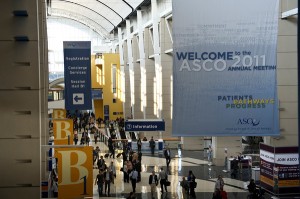The American Society for Clinical Oncology (ASCO) held its annual meeting in Chicago from June 2-7, an extraordinary gathering of over 35,000 cancer experts and advocates from around the world. This year, according to TNBCF Medical Advisory Board Member, Eric Winer, MD, there was no study presented on TNBC that represents a major step forward or will have a significant immediate impact on clinical practice. That statement is true for the meeting as a whole in which the majority of studies were focused on incremental advances, especially in the area of targeted therapies.
Iniparib Phase III Study fails to show an Improvement in Survival
The biggest news for TNBC patients actually relates to a study that failed to meet its two primary endpoints. In 2010, data from the Phase II study that added iniparib to the standard chemotherapy regimen of gemcitabine and carboplatin suggested a real advantage to the iniparib arm—and generated a surge of excitement. The buzz died quickly in January when the Phase III trial results didn’t showed no statistically significant advantage in either overall survival or progression free survival when iniparib was added to the standard regimen.
In a special briefing for breast cancer advocates, Charles Hugh-Jones, VP of US medical operations for Sanofi-aventis which makes iniparib conceded that overall the trial had been disappointing. He also pointed out that the data do appear to indicate an advantage to for TNBC patients receiving who get the iniparib/gemcitabine/carboplatin after failing one or more previous chemotherapy regimens. He also noted that laboratory research now indicates that while iniparib has anti-cancer activity, it is not as previously believed a PARP inhibitor. PARP inhibitors are a relatively new group of anti-cancer agents that work by interfering with a cancer cell’s ability to repair damage to its DNA—thus potentially greatly enhancing the effect of chemotherapy and radiation therapy. Hugh-Jones told the advocates that Sanofi is committed to ongoing work with iniparib both to understand its exact mechanism of activity and to determine the subsets of TNBC patients for whom it is effective.
From Eric Winer’s perspective, the iniparib trial is a strong testament to the value of rigorous clinical trials. He notes that, as in usually the case, the Phase II trial was small, enrolling a total of 122 patients in both arms. Phase II trials are used to generate data to drive the much larger Phase III studies—but smaller sample sizes, shorter time frames and the lack of stratification among the patients on the trial can in some instances lead to results that are not borne out in future studies.
“It’s all about expectations,” he says. “All of us—patients, doctors and the pharmaceutical companies—were excited by the Phase II results, and disappointed by the Phase III negative trial. But that’s why we it is so important to do these randomized trials.”
Study shows advantage for regional node radiation
Women with node positive or high risk node negative breast usually receive whole breast radiation therapy following their surgery. A Canadian study indicates that expanding the area irradiated to include regional lymph nodes improves disease free survival, reducing cancer recurrences both near the tumor site and in other part of the body. Regional node irradiation also improved overall survival but not a level that reached statistical significance. Women who received the RNI did have a low but statistically significant increase in grade II lymphedema .
“These results will encourage physicians to offer all women with node-positive disease the option of receiving regional node irradiation,” said Timothy J. Whelan, BM, BCh, lead investigator of the trial.
Prevention study significantly reduces risk of invasive breast cancer
For women who are already confronting a diagnosis of TNBC positive results from a prevention study may seem too late and too little—but for all of us the real hope for the future is no one will have to hear the words “you have breast cancer.” A study presented at ASCO offers the real possibility of reducing the risk of invasive breast cancer using the aromatase inhibitor exemestane. In this large randomized, double-blind trial, (MAP.3 conducted by the National Cancer Institute of Canada), post-menopausal women who were at high risk of getting breast cancer who took exemestane had a 65% reduced risk of developing invasive breast cancer compared to the group receiving a placebo. Women receiving the exemestane reported more symptoms, including hot flashes, fatigue, sweating, insomnia and arthralgia—all known effects of aromatase inhibitors—but according to the study leaders, these did not affect overall health-related quality of life.
While the results were highly significant and the potentially impact on public health is enormous, some experts expressed doubt as to whether women and their doctors would begin using an aromatase inhibitor as a preventive measure.
“It’s an important study,” said Winer, “but we know that a percentage of women being treated for breast cancer discontinue aromatase inhibitors because of the side effects, so it may be difficult to persuade healthy women to take these drugs. It’s not for everyone but for women who are truly at high risk for getting breast cancer, it could be very significant.”
Focus on TNBC and the future
There is no question that researchers are increasingly recognizing the importance of TNBC as an entity and focusing their efforts on several key areas, including:
• Defining exactly what comprises TNBC and developing more sensitive biomarkers for identifying which patients have this disease.
• Within the TNBC patient population, identifying which subsets of patients will benefit from specific targeted therapies
• Identifying new agents and combinations of existing agents that improve the treatment outcomes for TNBC patients.
It was notable at this year’s meeting that TNBC was the topic of a number of international presentations focusing on patient characteristics and treatment approaches in countries around the world. The key to progress is to having the best minds—both in the lab and the clinic—focused on understanding the biology of TNBC and using that knowledge to develop effective, targeted therapies.




 Posted by TNBC Foundation
Posted by TNBC Foundation 